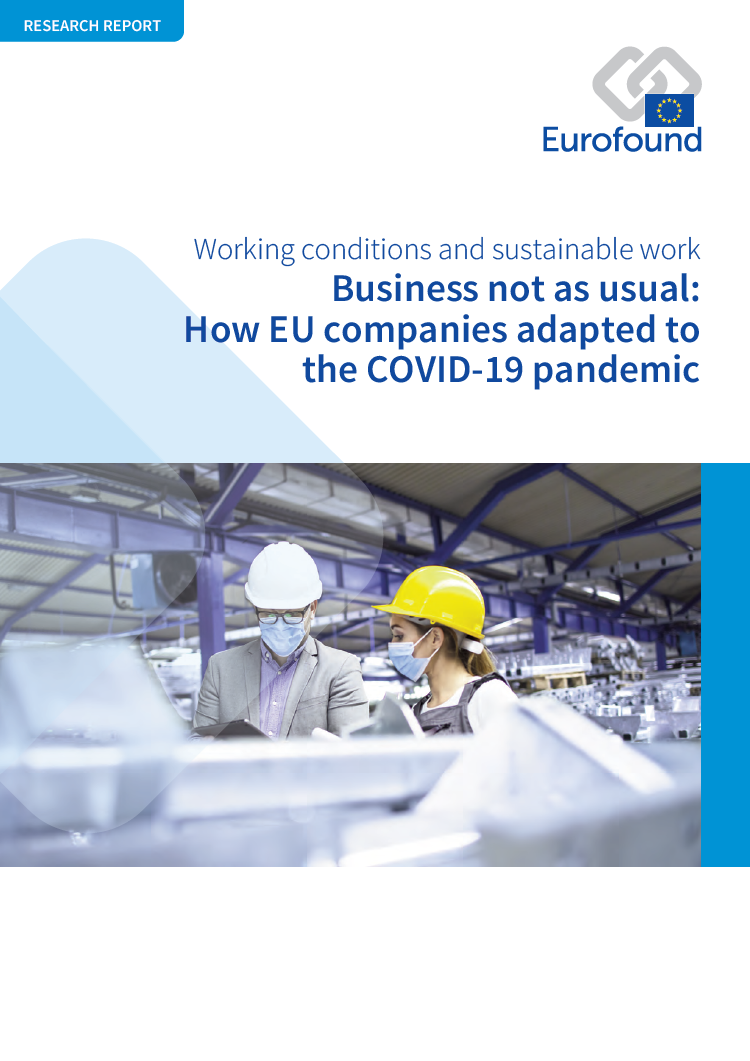
La presente relazione mira a sostenere le imprese europee nella gestione delle sfide legate alla pandemia di COVID-19. Si incentra sulle pratiche adottate nei luoghi di lavoro e sui fattori che hanno aiutato le imprese dell’UE a sviluppare una resilienza operativa, proteggendo nel contempo i dipendenti e i clienti.
La relazione esamina la reazione iniziale delle imprese dell’UE allo shock esterno derivante dal diffondersi della pandemia e gli adeguamenti successivamente introdotti nei luoghi di lavoro. Analizza inoltre l’impatto della pandemia sulla salute e sul benessere dei lavoratori e il modo in cui il diffondersi della COVID-19 e le successivi perturbazioni hanno influenzato le attività e l’organizzazione del lavoro.
Key findings
A seguito della pandemia, in quasi un’impresa su cinque nell’UE sono stati persi posti di lavoro. Circa il 40 % delle imprese dell’UE ha dovuto ridurre l’orario di lavoro dei dipendenti e in quasi un quarto (23 %) tale riduzione ha riguardato la maggior parte dei lavoratori.
Nel 2020 quasi la metà di tutte le imprese dell’UE ha dovuto in qualche modo sospendere le operazioni a causa della COVID-19. I fornitori di servizi finanziari e di altro tipo, le società di trasporti e quelle del settore dell’ospitalità sono stati i più colpiti dall’impatto dei lockdown successivi collegati alle misure di salute pubblica.
Nel 2020 oltre un terzo delle imprese dell’UE ha modificato la propria attività principale in risposta alla COVID-19. Molte società hanno diversificato le proprie linee di produzione, passando alla produzione di dispositivi di protezione, respiratori, strumenti di sanificazione e altri apparecchi urgentemente necessari.
Le organizzazioni possono trarre lezioni chiare dalla crisi. Le imprese che hanno investito nei dipendenti e li hanno coinvolti nel processo decisionale se la sono cavata meglio; queste imprese ad alto livello di coinvolgimento e investimento hanno anche avuto maggiori probabilità di disporre di un piano di gestione della crisi, modificare le loro attività principali e assumere nuovo personale nel 2020. Una gestione lungimirante è stata un altro dei fattori fondamentali, insieme a un buon ambiente di lavoro, a un’efficace strategia di comunicazione con il personale e con i clienti e alla fornitura al personale di attrezzature per consentire un orario di lavoro flessibile.
Le sfide fisiche ed emotive emerse durante la COVID-19 sono state diverse per i lavoratori sul posto e i lavoratori da casa. Sebbene entrambi i tipi di lavoratori abbiano menzionato stanchezza legata alla pandemia e mancanza di motivazione, i telelavoratori hanno citato il design ergonomico non adatto dei luoghi di lavoro in remoto, le difficoltà della didattica a domicilio e la frustrazione associata a ambienti monotoni, mentre i lavoratori sul posto hanno evidenziato i timori legati al contagio e la modifica radicale delle pratiche sul posto di lavoro.
This report contains the following list of tables and figures.
List of tables
Table 1: Distribution of Eurofound case studies
Table 2: Reduction in working time due to COVID-19, by establishment characteristics
Table 3: Average establishment performance levels by establishment characteristics, indexed mean, standard errors and % change in indexed mean
Table 4: Findings on telework-related aspects (%)
Table 5: Establishment performance and workplace well-being by work characteristics and management style, mean and standard errors
List of figures
Figure 1: Change in number of employees by sector, 2019 and 2020 (%)
Figure 2: Change in number of employees by establishment type, 2019 and 2020 (%)
Figure 3: Reduction in working time due to COVID-19, by sector (%)
Figure 4: Proportion of establishments reporting profit/loss, 2019 and 2020 (%)
Figure 5: Proportion of establishments reporting increases/decreases in production volume, 2019 and 2020 (%)
Figure 6: Complete or partial suspension of business (%)
Figure 7: Complete or partial suspension of business activity by sector (%)
Figure 8: Change in employment by degree of business suspension (%)
Figure 9: Profit outlook by business suspensions (%)
Figure 10: Production/service volume developments by business suspensions (%)
Figure 11: Change in business activities by sector and disruption (%)
Figure 12: Change in knowledge and skills needs due to COVID-19, EU27 (%)
Figure 13: Establishments with substantial or moderate change in knowledge and skills needs due to COVID-19, by establishment type, EU27 (%)
Figure 14: Motivation by types of change in establishments (%)
Figure 15: Change in establishments’ physical infrastructure due to COVID-19 (%)
Figure 16: Change in establishments’ physical infrastructure due to COVID-19 by sector (%)
Figure 17: Organisational changes due to COVID-19 by sector (%)
Figure 18: Telework by proportion of employees and time, 2019 and 2020 (%)
Figure 19: Telework by establishment size, 2019 and 2020 (%)
Figure 20: Provisions for telework made by employer (%)
Figure 21: Extent to which each element of the management approach has become more important because of the pandemic (%)
Figure 22: Problem solving and work autonomy, 2019 and 2020 (%)
Figure 23: Job complexity and work autonomy, indexed values (mean = 100), 2019 and 2020
Figure 24: Discretionary behaviour, 2019 and 2020 (%)
Figure 25: Use of internal communication channels, 2019 and 2020 (%)
Figure 26: Business continuity plan or contingency plan previously in place by various variables (% and standard errors)
Figure 27: Psychosocial risks in EU27 establishments in 2019 (% of managers reporting)
Figure 28: Measures to record working time by employee representation (ER) (%)
Figure 29: Employee motivation by employee representation (ER) (%)
Figure 30: Direct employee participation (%)
- Number of pages
-
80
- Reference nº
-
EF21033
- ISBN
-
978-92-897-2224-7
- Catalogue nº
-
TJ-05-21-333-EN-N
- DOI
-
10.2806/98958
- Permalink
Cite this publication
Eurofound (2021), Business not as usual: How EU companies adapted to the COVID-19 pandemic, Publications Office of the European Union, Luxembourg.
